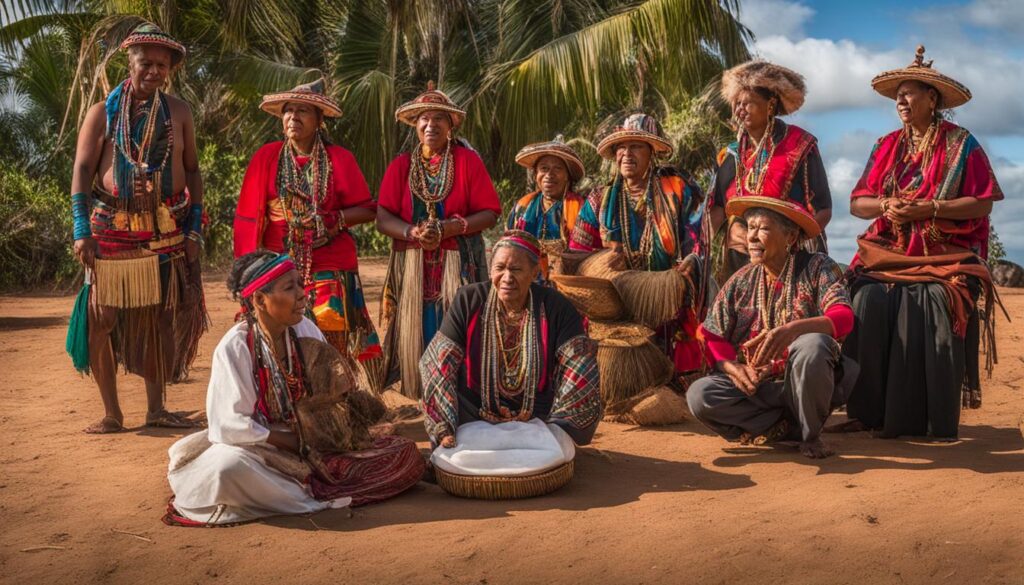Kaloeng is a Southwestern Tai language spoken in Thailand and Laos. It belongs to the Kra-Dai language family and is written using the Thai alphabet. In Thailand, Kaloeng is primarily spoken in Sakon Nakhon Province, Nakhon Phanom Province, and Mukdahan Province, while in Laos, it is spoken in Khammouan Province. The Kaloeng language is classified as part of the Sakon Nakhon sub-branch of the Southwestern Tai. The language displays unique features such as the change of Proto-Tai *hw- and *w- to /ph-/ in Sakon Nakhon languages and the presence of uncommon labiovelar initial clusters in the language.
Key Takeaways:
- Kaloeng is a Southwestern Tai language spoken in Thailand and Laos.
- The language is primarily spoken in Sakon Nakhon Province, Nakhon Phanom Province, and Mukdahan Province in Thailand, and Khammouan Province in Laos.
- Kaloeng belongs to the Sakon Nakhon sub-branch of the Southwestern Tai.
- The language exhibits unique features, including the change of Proto-Tai *hw- and *w- to /ph-/ in Sakon Nakhon languages.
- Uncommon labiovelar initial clusters are present in the Kaloeng language.
Distribution of Kaloeng Language
The Kaloeng language is primarily spoken in three provinces in Thailand, namely Sakon Nakhon Province, Nakhon Phanom Province, and Mukdahan Province. Additionally, it is also spoken in the Khammouan Province of Laos. The concentrated distribution of Kaloeng speakers in these regions highlights the regional significance and influence of the language.
Kaloeng’s presence in these provinces in both Thailand and Laos demonstrates its importance within these communities and their cultural identity. The language serves as a means of communication, preserving unique linguistic features, oral traditions, and cultural heritage.
Here is a breakdown of the distribution of Kaloeng language:
| Country | Provinces |
|---|---|
| Thailand | Sakon Nakhon Province |
| Nakhon Phanom Province | |
| Mukdahan Province | |
| Laos | Khammouan Province |
The presence of Kaloeng in these provinces plays a vital role in its preservation and continued use. It creates opportunities for intergenerational transmission and fosters a sense of community among Kaloeng speakers.
External Classification of Kaloeng Language
The Kaloeng language is classified as part of the Sakon Nakhon subbranch of the Southwestern Tai. This classification places it within a broader linguistic group and highlights its linguistic similarities and connections. The inclusion of Kaloeng in the Southwestern Tai branch allows for a better understanding of its linguistic features and its relation to other languages within the same subbranch.

Understanding the external classification of the Kaloeng language provides valuable insights into its linguistic affiliation and relationship with other languages. As part of the Sakon Nakhon subbranch of the Southwestern Tai, the Kaloeng language shares common characteristics and features with related languages in the region.
The Southwestern Tai language family encompasses a group of languages primarily spoken in Thailand and Laos. These languages are part of the larger Kra-Dai language family, which includes several branches and sub-branches. The Sakon Nakhon subbranch, to which Kaloeng language belongs, is a specific classification within the Southwestern Tai branch.
The external classification of the Kaloeng language aids in the study of its historical development, linguistic evolution, and patterns of language change. It allows linguists and researchers to compare and analyze the Kaloeng language alongside other languages within the same subbranch, shedding light on its unique features and linguistic relationships.
The inclusion of the Kaloeng language in the Sakon Nakhon subbranch of the Southwestern Tai provides a framework for understanding its place within the broader linguistic landscape. This classification is instrumental in identifying the shared linguistic heritage and connections between Kaloeng and other languages in the region.
Linguistic Features and Similarities
By classifying Kaloeng as part of the Southwestern Tai branch, linguists can identify common linguistic features and patterns within this group of languages. These features may include phonological aspects, grammar, vocabulary, and language structures that are shared among languages within the same subbranch.
Additionally, the external classification of Kaloeng language facilitates comparative studies, allowing linguists to explore the historical development and diversification of languages in the Southwestern Tai branch. Through these comparative studies, researchers can unravel the intricate connections and language shifts that have shaped the linguistic landscape of the region.
Comparison of Kaloeng Language and Related Languages within the Southwestern Tai Subbranch
| Language | Common Characteristics |
|---|---|
| A | Shared phonological patterns |
| B | Similar grammatical structures |
| C | Overlap in vocabulary |
| Kaloeng Language | Unique labiovelar initial clusters |
| D | Common language evolution |
The table above highlights some common characteristics and unique features of the Kaloeng language in comparison to related languages within the same subbranch. These characteristics provide valuable insights into the linguistic diversity and features specific to the Kaloeng language.
Internal Classification of Kaloeng Language
The Kaloeng language, belonging to the Southwestern Tai family, displays a fascinating internal classification based on the evolution of the Proto-Kaloeng diphthong *-aɯ. Thananan Trongdee, a renowned linguist, has classified the Kaloeng dialects into three distinct groups: *-aɯ > -aɯ, *-aɯ > -əi, and *-aɯ > -ai. These classifications are based on the spoken dialects in specific districts and provinces throughout Laos and Thailand, providing insights into the linguistic diversity within the Kaloeng language and highlighting the dialectal differences among Kaloeng speakers.
| Dialect Group | Proto-Kaloeng Diphthong Evolution |
|---|---|
| *-aɯ > -aɯ | Example: “naɯ” becomes “naɯ” in the respective dialects |
| *-aɯ > -əi | Example: “naɯ” becomes “nəi” in the respective dialects |
| *-aɯ > -ai | Example: “naɯ” becomes “nai” in the respective dialects |
This internal classification of the Kaloeng language allows linguists and researchers to delve deeper into the structural and phonological variations within the language. It exemplifies the rich and dynamic nature of Kaloeng as a distinct linguistic entity. Additionally, understanding the internal classification of the Kaloeng language aids in the documentation and preservation of its diverse dialectal forms for future generations.
Indigenous Knowledge and Transmission of Kaloeng Language
The Kaloeng ethnic group possesses a wealth of indigenous knowledge that is deeply intertwined with the exploitation of natural resources. This knowledge encompasses various domains, such as gathering forest products, hunting, animal raising, and paddy cultivation. The transmission of this invaluable knowledge ensures the sustainable conservation and co-existence with the natural resources of the Kaloeng communities.
To pass down their indigenous knowledge, the Kaloeng people employ a range of methods that have withstood the test of time. These methods include rituals, actual practices, Buddhist teachings, sharing experiences, folklore, trial and error, as well as the guidance of folk teachers. Through these means, the rich cultural heritage and traditional practices of the Kaloeng ethnic group are safeguarded and preserved for future generations.

This image showcases the essence of the Kaloeng ethnic group’s indigenous knowledge and its significance in the context of natural resources, rituals, folklore, and the transmission of the Kaloeng language. The image serves as a visual representation of the interconnectedness between the Kaloeng language and the indigenous knowledge that sustains the community’s relationship with their surroundings.
By passing down their indigenous knowledge from one generation to another, the Kaloeng people ensure the continuous stewardship of their natural surroundings. The transmission of this knowledge instills a sense of responsibility, respect, and harmony in their interactions with the environment. It is through the preservation of their language, cultural practices, and ancestral wisdom that the Kaloeng ethnic group maintains their unique identity and sustains the balance between their community and the natural world.
The Importance of Rituals, Folklore, and Folk Teachers
Rituals play a vital role in the transmission of indigenous knowledge within the Kaloeng community. These sacred ceremonies not only serve as a means of preserving cultural practices but also as a platform for imparting wisdom and understanding to the younger generation. Through participation in rituals, the Kaloeng people learn the importance of respecting nature and the intricate relationship between their language, traditions, and the natural resources they rely on.
“The Kaloeng people have passed down their indigenous knowledge through centuries of rituals, actual practices, and the wisdom of folk teachers.”
Folklore, too, holds a special place in the transmission of knowledge within the Kaloeng community. It is through stories, legends, and myths that ancestral wisdom is conveyed, ensuring that traditional values and practices continue to shape the collective consciousness of the Kaloeng people. These tales offer profound insights into the Kaloeng language, their connection to the environment, and the preservation of their cultural heritage.
Folk teachers, revered for their wisdom and experience, serve as the custodians of indigenous knowledge among the Kaloeng community. They are entrusted with the responsibility of imparting ancestral wisdom, teaching practical skills, and instilling a deep appreciation for the Kaloeng language. The guidance of folk teachers ensures the continuity and authenticity of the transmission process, fostering a strong sense of cultural pride and identity among the Kaloeng people.
Methods of Indigenous Knowledge Transmission among the Kaloeng Ethnic Group
| Methods | Description |
|---|---|
| Rituals | Sacred ceremonies that weave together cultural practices and impart wisdom to younger generations. |
| Actual practices | Engaging in traditional activities that reinforce indigenous knowledge and skills. |
| Buddhist teachings | Teachings and principles that emphasize respect for nature and connectedness to the environment. |
| Sharing experiences | Oral traditions that pass down knowledge through personal stories and anecdotes. |
| Folklore | Myths, legends, and stories that convey ancestral wisdom and values. |
| Trial and error | Learning through hands-on experience and iterative experimentation. |
| Customs and taboos | Traditional practices and restrictions that preserve cultural norms and sustain natural resources. |
| Folk teachers | Knowledge keepers who impart ancestral wisdom, skills, and cultural pride to younger generations. |
Cultural Significance of Kaloeng Language
The Kaloeng language holds immense cultural significance within the Kaloeng ethnic group. It serves as a mirror reflecting their rich heritage, vibrant traditions, and distinctive way of life. This language plays a pivotal role in preserving and transmitting their cultural knowledge, captivating stories, and cherished customs from one generation to the next.
The Kaloeng language is not just a means of communication; it is deeply ingrained in the identity of the Kaloeng people. It forms an integral part of their cultural heritage, acting as a thread that connects them to their shared past and binds them together as a community.
Through the Kaloeng language, the Kaloeng ethnic group keeps their traditions alive and ensures their continuity for future generations. It is through this language that ancestral wisdom is passed down, enabling the preservation of rituals, dances, songs, and other cultural practices that embody the essence of their unique heritage.
“The Kaloeng language is the pulse that beats within our community, reminding us of our roots, shaping our present, and guiding us into the future.”
Moreover, the Kaloeng language serves as a gateway to understanding the cultural diversity that thrives in Thailand and Laos. It embodies the linguistic treasures and cultural nuances that make these regions so enriching and captivating.
As we delve deeper into the intricate tapestry of the Kaloeng language, we gain a greater appreciation for the customs, beliefs, and values that form the foundation of the Kaloeng ethnic group. It is through embracing and celebrating the cultural significance of the Kaloeng language that we foster greater intercultural understanding and forge bonds of solidarity with diverse communities.
Preserving the Intangible Cultural Heritage
The Kaloeng language acts as a powerful tool for preserving the intangible cultural heritage of the Kaloeng ethnic group. It breathes life into traditions that might otherwise fade away and ensures that the vibrant tapestry of Kaloeng culture remains intact.
Through their language, the Kaloeng people can retain their unique knowledge, stories, wisdom, and customs, safeguarding them from the passage of time. It is a testament to the resilience and determination of the Kaloeng community to preserve their cultural heritage and pass it on to future generations.
“The Kaloeng language is not just words; it is a living embodiment of our ancestors’ wisdom and our cultural legacy. It is our duty to protect and cherish it.”
By recognizing and honoring the cultural significance of the Kaloeng language, we contribute to the preservation and promotion of cultural diversity, fostering mutual respect and appreciation for the rich tapestry of human expression.
Conclusion
The Kaloeng language is a Southwestern Tai language spoken in Thailand and Laos, with its primary distribution in Sakon Nakhon Province, Nakhon Phanom Province, Mukdahan Province in Thailand, and Khammouan Province in Laos. This language holds significant cultural importance within the Kaloeng ethnic group and plays a vital role in preserving their heritage and traditions.
One of the remarkable aspects of the Kaloeng language is its unique features, which set it apart from other languages in the Southwestern Tai branch. The language exhibits distinct linguistic characteristics, such as the change of certain sounds and the presence of uncommon initial clusters. These features contribute to the linguistic diversity and richness of the Kaloeng language.
Moreover, the Kaloeng ethnic group possesses valuable indigenous knowledge related to the sustainable exploitation of natural resources. This knowledge is transmitted through various methods, including rituals, actual practices, teachings, folklore, and shared experiences. By passing down their indigenous knowledge, the Kaloeng community ensures the sustainable conservation and harmonious co-existence with the environment.
In conclusion, the Kaloeng language not only serves as a means of communication but also plays a crucial role in preserving the cultural heritage of the Kaloeng ethnic group. Through its unique linguistic features and the transmission of indigenous knowledge, the Kaloeng language contributes to the cultural identity and sustainable development of the Kaloeng community.
FAQ
What is the Kaloeng language?
The Kaloeng language is a Southwestern Tai language spoken in Thailand and Laos. It belongs to the Kra-Dai language family and is primarily spoken in Sakon Nakhon Province, Nakhon Phanom Province, and Mukdahan Province in Thailand, as well as Khammouan Province in Laos. The language is written using the Thai alphabet and exhibits unique linguistic features.
Where is the Kaloeng language primarily spoken?
The Kaloeng language is primarily spoken in three provinces in Thailand: Sakon Nakhon Province, Nakhon Phanom Province, and Mukdahan Province. It is also spoken in Khammouan Province in Laos. These regions serve as the main areas where Kaloeng is prevalent, indicating its regional significance and influence.
How is the Kaloeng language classified?
The Kaloeng language is classified as part of the Sakon Nakhon subbranch of the Southwestern Tai. This classification allows for a better understanding of its linguistic features and its relation to other languages within the same subbranch.
How is the Kaloeng language internally classified?
The Kaloeng language can be internally classified based on the evolution of the Proto-Kaloeng diphthong *-aɯ. It is divided into three groups: *-aɯ > -aɯ, *-aɯ > -əi, and *-aɯ > -ai. These classifications are based on spoken dialects in specific districts and provinces in Laos and Thailand, showcasing the linguistic diversity within the Kaloeng language and the dialectal differences among Kaloeng speakers.
What is the significance of indigenous knowledge in the Kaloeng language?
The Kaloeng ethnic group possesses indigenous knowledge related to the exploitation of natural resources. This knowledge, which includes practices such as gathering forest products, hunting, animal raising, and paddy cultivation, is transmitted through various methods such as rituals, actual practices, Buddhist teachings, sharing experiences, folklore, trial and error, customs, taboos, and folk teachers. The transmission of this indigenous knowledge plays a crucial role in the sustainable conservation of and co-existence with natural resources in Kaloeng communities.
What is the cultural significance of the Kaloeng language?
The Kaloeng language holds significant cultural importance within the Kaloeng ethnic group. It serves as a reflection of their heritage, traditions, and way of life. The language is used to preserve and transmit cultural knowledge, stories, and customs from one generation to another. It is an integral part of their identity and plays a vital role in maintaining their cultural heritage.
